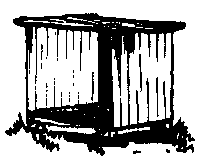Shelter For Goats
Shelter is one of the first considerations when contemplating the purchase of a doe. She cannot be expected to produce her best when she has to contend with Nature's elements. Without shelter and good food, it means she has to utilise more of what she eats to keep her warm.
Housing does not present a problem, as long as it is rain and draught-proof, as the simplest of shelters is much appreciated in cold, wet weather.
Shelter ranging from an oversized box to the most elaborate of barns can be within the scope of everyone. It is all a matter of taste, economy and/or pride.
When the doe or buck is tethered, and he or she has to be shifted frequently, a large box or a discarded water tank is the ideal shelter, as it is easily moved from place to place. Do not forget to place a layer of hay on the bottom of the box to keep her warm or dry. If using an old tank it is much better to make a slatted platform for sleeping on, as any moisture tends to run to the bottom and remain there. Place a block or log either side to prevent the tank from rolling.
Where the building of a barn is comtemplated, there are one or two points to remember. Ease of cleaning out is of main importance. There is nothing more tiring than having to walk and manoeuvre unnecessarily. Access to feeding racks when feeding out hay or greens is another point to bear in mind too. It is much easier to feed without having to go into the shed each time, especially when there are several does.
Flooring can be several kinds; concrete, wood, asphalt or earth. But whichever method is used, litter in some form must be provided. Sprinkling the floor with lime after each cleaning out will keep the shed smelling clean and sweet, and will discourage flies from breeding in the litter.
Where the area of shedding is available slatted platforms, or boxes with slatted tops, can be used for sleeping. In this way the droppings can be collected and used for the garden. We have found fence battens are a convenient size for making platforms.
A hayrack can be made from a wooden frame covered with large mesh netting, and hung on the wall within easy reach of the goats. Plastic buckets make ideal containers for grain feed and water, as they are easily kept clean. Salt licks are best placed in a wooden container because of the corrosive nature of the salt.
...reprinted from Household Dairy Goats for Beginners by Joyce Collins




